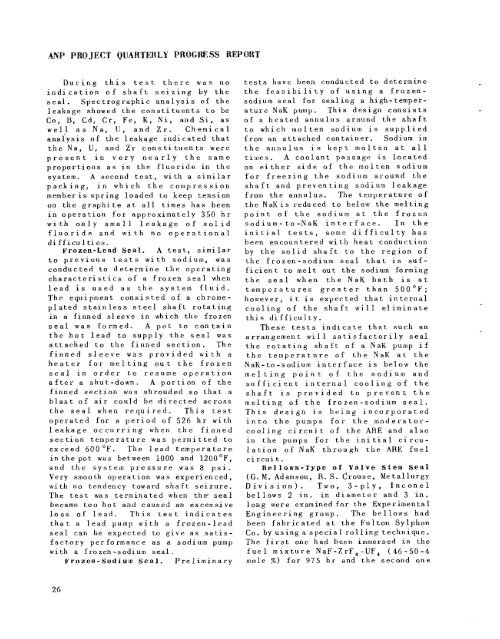the Molten Salt Energy Technologies Web Site
the Molten Salt Energy Technologies Web Site
the Molten Salt Energy Technologies Web Site
Create successful ePaper yourself
Turn your PDF publications into a flip-book with our unique Google optimized e-Paper software.
ANP PROJECT QUARTERLY PROGRESS REPORT<br />
During this test <strong>the</strong>re was no<br />
indication of shaft seizing by <strong>the</strong><br />
seal. Spectrographic analysis of <strong>the</strong><br />
leakage showed <strong>the</strong> constituents to be<br />
Co, U, Cd, Cr, Fe, K, Ni, and Si, as<br />
w e l l as Na, U, and Zr. Chemical<br />
analysis of <strong>the</strong> leakage indicated that<br />
<strong>the</strong> Na, U, and Zr constituents were<br />
present in very nearly <strong>the</strong> same<br />
proportions as in <strong>the</strong> fluoride in <strong>the</strong><br />
system. A second test, with a similar<br />
packing, in which <strong>the</strong> compression<br />
member is spring loaded to keep tension<br />
on <strong>the</strong> graphite at all times has been<br />
in operation for approximately 350 hr<br />
with only small leakage of solid<br />
fluoride and with no operationa.1<br />
difficulties.<br />
Frozen-Lead Seal. A test, similar<br />
to previous tests with sodium, was<br />
conducted to determine <strong>the</strong> operating<br />
characteristics of a frozen seal when<br />
lead is used as <strong>the</strong> system fluid,<br />
The equipment consisted of a chromeplated<br />
stainless steel shaft rotating<br />
in a finned sleeve in which <strong>the</strong> frozen<br />
seal was formed. A pot to contain<br />
<strong>the</strong> hot lead to supply t.he seal was<br />
attached to <strong>the</strong> finned section. 'The<br />
finned sleeve was provided with a<br />
heater for melting out <strong>the</strong> frozen<br />
seal in order to resume operation<br />
after a shut-down. A portion of <strong>the</strong><br />
finned section was shrouded so that a<br />
b1.ast of air could he directed across<br />
<strong>the</strong> seal when required, This test<br />
operated for a period of 526 hr with<br />
leakage occurring when <strong>the</strong> finned<br />
section temperature was permitted to<br />
exceed 600°F. The lead temperature<br />
in <strong>the</strong> pot was between 1000 and 1200"F,<br />
and <strong>the</strong> system pressure was 8 psi.<br />
Very smooth operation was experienced,<br />
with no tendency toward shaft seizure.<br />
The test was terminated when <strong>the</strong> seal<br />
became too hot and caused an excessive<br />
loss of lead. This test indicates<br />
that a lead pump with a frozen-lead<br />
seal. can be expected to give as satisfactory<br />
performance as a sodium pump<br />
with a f ro Zen -sodium seal<br />
Frozen- Sod i u na Sea 1. Prelim in a ry<br />
26<br />
tests have been conducted to determine<br />
<strong>the</strong> feasibility of using a frozen-<br />
sodium seal for sealing a high-temper-<br />
ature NaK pump. This design consists<br />
of a heated annulus around <strong>the</strong> shaft<br />
to which molten sodium is supplied<br />
from an attached container. Sodium in<br />
<strong>the</strong> annulus is kept molten at all<br />
times. A coolant passage is located<br />
on ei<strong>the</strong>r side of <strong>the</strong> molten sodium<br />
for freezing <strong>the</strong> sodium around <strong>the</strong><br />
shaft and preventing sodium leakage<br />
from <strong>the</strong> annulus. The temperature of<br />
<strong>the</strong> NaKFs reduced to below <strong>the</strong> melting<br />
point of <strong>the</strong> sodium at <strong>the</strong> frozen<br />
sodium-to-NaK interface. In <strong>the</strong><br />
initial tests, some difficulty has<br />
been encountered with heat conduccian<br />
by <strong>the</strong> solid shaft to <strong>the</strong> region of<br />
<strong>the</strong> frozen-sodium seal that is suf-<br />
ficient to melt out <strong>the</strong> sodium forming<br />
<strong>the</strong> seal when <strong>the</strong> NaK bath is at<br />
temperatures greater than 500°F;<br />
however, it is expected that internal<br />
cooling of <strong>the</strong> shaft w i l l eliminate<br />
thi R di f ficult y.<br />
These tests indicate that such an<br />
arrangement w i l l satisfactorily seal<br />
<strong>the</strong> rotating shaft of a NaK pump if<br />
<strong>the</strong> temperature of <strong>the</strong> NaK at <strong>the</strong><br />
NaK-to-sodium interface is below <strong>the</strong><br />
melting point of <strong>the</strong> sodium and<br />
sufficient internal cooling of <strong>the</strong><br />
shaft is provided to prevent <strong>the</strong><br />
melting of <strong>the</strong> frozen-sodium seal.<br />
This design is being incorporated<br />
into <strong>the</strong> pumps for <strong>the</strong> moderator-<br />
cooling circuit of <strong>the</strong> ARE and also<br />
in <strong>the</strong> pumps for <strong>the</strong> initial circu-<br />
lation of NaK through <strong>the</strong> ARE fuel<br />
circuit.<br />
Bellows-Type of Valve Stem Seal<br />
(G. M. Adamson, R. S. drouse, Metallurgy<br />
Division). Two, 3-ply, Inconel<br />
bellows 2 in. in diameter and 3 in.<br />
long were examined for <strong>the</strong> Experimental<br />
Engineering group. The bellows had<br />
been fabricated at <strong>the</strong> Fulton Sylphon<br />
Co. by using a special rolling technique.<br />
The first one had been immersed in t;he<br />
fuel mixture NaF-ZrF,-UF, (46-50-4<br />
mole %) for 975 hr and <strong>the</strong> second one



![Review of Molten Salt Reactor Physics Calculations [Disc 2]](https://img.yumpu.com/21979492/1/190x247/review-of-molten-salt-reactor-physics-calculations-disc-2.jpg?quality=85)












